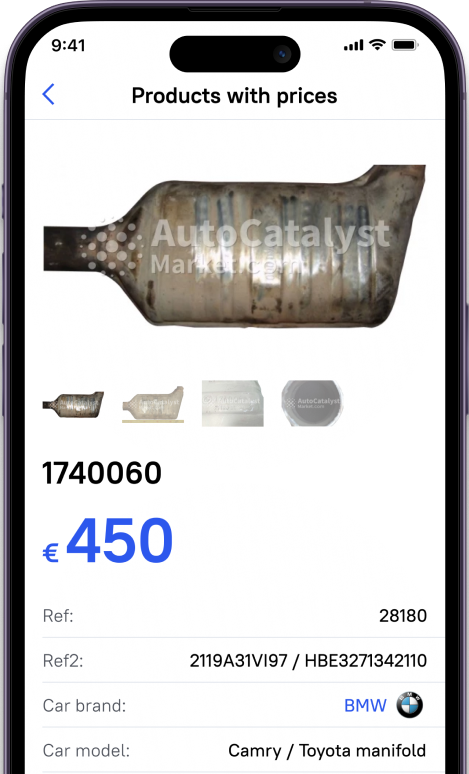- Pros and cons of catalytic converter removal
- Consequences of driving without a catalytic converter
- Is it legal to drive without a catalyst?
- Repair of catalytic converters
- How to replace the catalytic converter?
- How much does it cost to get a catalytic converter replaced
- How long does it take to replace a catalytic converter?
- How to make money from used catalysts?
- Service stations
- ScrapYards
- Online Platforms
First of all let us tell a few raw prices of catalytic converters to answer the key question: how much does it cost to replace a catalytic converter? After that, we will have a detailed talk on the pros and cons.
If the vehicle was produced before the 80s then the catalytic converter will cost up to eight hundred dollars. The cost of a catalyst is about six hundred, but a labor cost will be added. So keep it in mind that the older the car the bigger the sum you have to spend to race an old catalyst. Newer cars request even more money to replace catalytic converters, which will go even further to 2500 dollars. If there is a chance to remove the catalyst at home with proper tools, then there will be a way to save money, but sometimes there is no way to purchase a catalytic converter if you are not authorized for it.
In a meanwhile, one might think that removing a catalyst means to harm the environment. On the other hand, this slightly increases the power of the motor, reduces fuel consumption, and gets rid of regular alerts about problems. The fused or clogged catalytic converter leads to the fact that exhaust gases cannot go outside and return to the combustion chamber. A combustible mixture that enters there becomes less efficient, and this negatively affects the operation of the motor.
Pros and cons of catalytic converter removal
Why is it necessary to remove the catalyst? Together with above mentioned dynamic characteristics of a car, as a bonus, the engine will become less sensitive to fuel quality, and you also eliminate the risk of ceramic dust getting inside the power plant. Old catalysts can be sold to recycling companies.
Consequences of driving without a catalytic converter
- Environmental factor.
- Problems during car inspection.
- Foul odor.
- Extraneous sounds in the exhaust system (if not removed correctly).
- Check engine light and emissions testing issues.
Consider the important role of oxygen sensors cooperating with catalytic converters.
Their second name is lambda sensors. Usually, they are installed in two places: one before and one after the catalytic converter. When the second sensor determines that the amount of harmful exhaust gases has increased to a critical level, it gives a signal that the catalytic converter has not worked or is functioning inefficiently. Some modern car models in this situation may not start.
The second lambda sensor carefully monitors harmful emissions, and their allowable amount is regulated by the EU. These are standards known as “EURO” (Euro-2, Euro-3, Euro-4, Euro-5). The EURO-5 standard is currently in operation, its emission standards are up to 0.05 g / km, CO - up to 0.8 g / km, and NO - up to 0.06 g / km.
When the exhaust system is without a catalyst, oxygen sensors will detect more harmful emissions. Accordingly, you need to make sure that you do not feel the absence of this important detail.
Is it legal to drive without a catalyst?
In many jurisdictions, it is illegal to operate a vehicle without a catalytic converter. Most modern vehicles are equipped with catalytic converters to reduce emissions and comply with environmental regulations. Operating a vehicle without one can lead to fines, citations, or even vehicle impoundment in some cases.
Repair of catalytic converters
There are various ways to repair catalytic converters: in some cases, the repair of the catalyst is carried out, according to regulations, to a new catalyst. We tried to briefly outline the main pros and cons of various types of repair of catalytic converters.
Diagnostics of catalytic converter. In many cases, the correct diagnosis of a catalyst allows you to understand the real cause of the breakdown and not just change the catalyst. Usually, catalytic converter errors can catch fire literally from scratch. For example, a catalyst error can catch fire from damage or other parts of the exhaust system. It could just “shut down” the wiring or computer. Types of diagnostics that are offered: computer diagnostics (reading all errors and their analysis), endoscopy of the catalytic converter (examination of the state of a catalyst), physical examination of the exhaust system, measurement of purity of exhaust gases for compliance with EURO4, EURO5, EURO6 standards.
- Replacing the catalytic converter with a new one. If you need a replacement for a catalyst, then it is due time to sell the old one. You can choose a catalyst that suits you with its cost and its properties. This repair path is undeniably the most correct, but the most unreliable in the long term, because after two thousand kilometers catalytic converter will again need to be replaced. The main advantage is that exhaust gases will be clean.
- Replacing the catalytic converter with a flame arrester. This procedure has two popular names, one of them is “replacing catalyst with a flame arrester,” and the other is “removing the catalyst”. In this case, you get rid of the catalyst and everything that is connected with it. But having removed it you will gain the following consequences: exhaust sound will become loud, exhaust system will easily burn out.
- Rinsing, and cleaning catalytic converter. In the case of the catalyst, an error has arisen because the catalyst is clogged with combustion products, and this is the only reason why the catalyst does not work. It is necessary to clean it and thereby remove any deposits. But if the functional catalyst deposition layer has lost its properties, then this does not make sense, and the replacement of the catalyst by one of the methods is required. Only diagnostics and inspection of the car can tell which is the best option for a catalytic converter.
Service stations will carry out exhaust system diagnostics to 100% determine whether it is worth cutting out the catalyst or, possibly cleaning it. It is difficult to determine the cause of failure yourself.
One way is to dismantle part of the exhaust system, including the catalytic converter, and remove the contents of the catalyst. Usually, several holes with a diameter of 20 mm are made using a punch. This method has disadvantages: holes quickly become clogged again. But there are also positive aspects since you do not have to cut metal and do welding.
How to replace the catalytic converter?
If you diagnosed a faulty catalyst it is time for replacement. Before engaging in any activities, make sure to disconnect the battery to prevent electrical mishaps during the replacement.
- Raise the Vehicle: Use a jack and jack stand or a hydraulic lift to raise the vehicle safely and securely. Ensure that the vehicle is supported on sturdy points to prevent accidents.
- Remove Old Catalytic Converter: Depending on the vehicle's design, use appropriate tools to unbolt and remove the old catalytic converter from the exhaust system. This may involve disconnecting oxygen sensors, exhaust pipes, and mounting brackets.
- Install New Catalytic Converter: Position the new catalytic converter in place and secure it according to the manufacturer's instructions. Reconnect any oxygen sensors, exhaust pipes, and mounting brackets.
- Check Seals and Connections: Double-check all seals and connections to ensure they are tight and leak-free. Proper sealing is crucial to prevent exhaust leaks and ensure optimal performance.
- Test Drive and inspection: Lower the vehicle and reconnect the battery. Start the engine and take the vehicle for a test drive to ensure proper operation of the new catalytic converter. Monitor for any unusual noises, smells, or performance issues. Additionally, conduct a visual inspection for leaks or abnormalities in the exhaust system.
It's important to note that the exact replacement process may vary depending on the make and model of the vehicle and any specific instructions provided by the manufacturer or service manual. If you're unsure about any steps, it's recommended to consult a professional mechanic for assistance but consider how much is it to replace catalytic converters, as the professional help may be costly. Learn more about the repair prices in our next paragraph.
How much does it cost to get a catalytic converter replaced
If you need to cut out the catalyst, the price will depend on what you want to get as a result. For those who are confused with a choice, experts can advise the best repair option.
Take a look at general figures and prices of a catalytic converter repair and the cost to replace catalytic converters for some common vehicle models. Find a way to save money, sell your old catalyst to a specialized recycling organization, and gain a good money bonus for future investments.
As you can see the average price to replace catalytic converters is about $750 and depends on the car make and its catalyst.
How long does it take to replace a catalytic converter?
Generally, replacing a catalytic converter can take anywhere from 1 to 3 hours for a straightforward replacement on a typical vehicle. However, this time estimate can vary significantly based on the factors such as:
- Vehicle type
- Skill level
- Tools and equipment
Hence, it is always better to have a professional overlook to make sure these factors are not to your disadvantage.
How to make money from used catalysts?
Catalytic converters are not a subject for usual disposal. They contain precious metals in the honeycomb that have value and many applications. Hence, catalytic recycling takes place here as the best way of disposal and the way to benefit. Here is how you can do it:
Service stations
Usually, service stations diagnosing faulty catalysts offer to sell your used unit to them.
Do not rush to carry your faulty catalyst to a service station, because they won’t give you a fair offer. What they are going to do is to sell your catalyst to make more money from recycling.
ScrapYards
Many people opt for scrapyards as they are a conventional and easy method, but that is another common mistake. Their pricing policy comes across their turnover. Hence, you still get more money compared to a service station, but it depends on how well is the business going in a specific scrapyard. Besides, to improve the business, scrapyards often involve illegal activities buying stolen catalytic converters which may cause issues for both parties.
Online Platforms
The best way to make money from your catalysts is to utilize online platforms such as AutoCatalystMarket. The site has large turnover rates bridging the gap between buyers and sellers online. The platform has reputable buyers that you can look up for a specific region in the ‘Buyer’s section. The site provides quotes and fair pricing to estimate the scrap value of your catalysts. The buyer company handles the process of recycling to give you an exact price considering the actual precious metal content inside your catalysts via precise analysis.










































